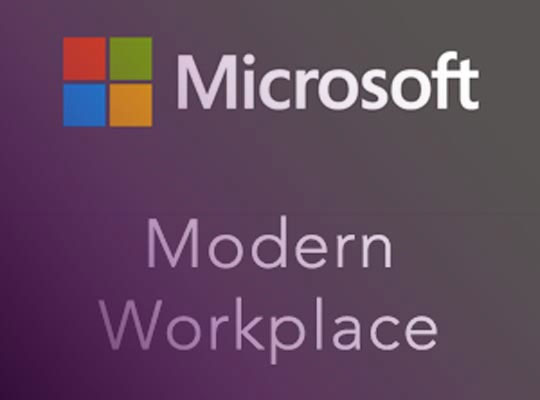
Microsoft Modern Workplace
The workplace has been evolving for two and a half million years - ever since the Stone Age, when the first Homo Habilis found that he could fashion stone hand axes and trade them for items produced by others. Throughout the ages, commerce and the workplace have been refined through milestones like the Industrial Revolution and the dawn of the Computer Age.
Now we are here – with the latest great change in the workplace brought about by the COVID pandemic.
The Hybrid Work model, where some work from home, some at the office and some work in a hybrid a mix of both, is here to stay. Productivity has improved – defying the conventional suspicion that a remote workforce will lay around watching TV and eating Cheetos.
The incredible surge in companies moving to cloud-based platforms demonstrated to many skeptical CEOs that the cloud is useful for more than offsite data backups and email. With the advent of Microsoft 365 and other services like Google Workspace, companies see the benefits of moving all of their data and communication centered applications to the cloud. The machines that manufacture and ship everything from shoes to cars are still earthbound, but every other aspect of running the enterprise can be moved to the cloud.
What exactly is the cloud?
The short answer is: the cloud refers to services and software that run on the internet rather than on a local workstation and network.
There – simple, right? Not even. Pick any reputable, experienced member of the IT Support Los Angeles Community and tell them you want to move to the cloud. That’s when the slew of questions begins: “Move what to the cloud – backups? Emails? All or part of your operations? What kind of cloud? What form of cloud computing works best for your needs?
This is why we advise consulting with a reputable, experienced IT Support firm – preferably a Managed IT Services provider. They will learn about your business, what you want and need to do, including the regulations with which you need to be compliant - HIPAA, PCI, CMMC etc. Only after performing a thorough ‘discovery’ can reliable recommendations be made.
It’s like saying you need to buy a car. Guaranteed that it won’t be some kind of one-size-fits-all generic ‘car’.
What is the Microsoft Modern Workplace?
Technically, Microsoft Modern Workplace is the new-generation Office 365 as included in the broader Microsoft 365 platform. It’s akin to asking two sports fans who won the 2020 World Series – even if one says, “The Dodgers” and the other says “L.A.”, they are talking about the same team. But there’s more to Microsoft’s Modern Workplace than just a renaming.
The issues that Modern Workplace solves are those concerned with maintaining and improving the type of flexibility a modern Hybrid Work force requires in terms of productivity, communication, and collaboration, but with advanced Multi-level Cybersecurity.
Since COVID, many organizations have spurred their Hybrid Work model into somewhat ‘thrown-together’ versions of modernization, but what Microsoft 365 does is create an all-inclusive and thoroughly secure platform that enables a truly modern workplace.
What does Microsoft modern workplace include?
This new generation suite of productivity tools features updated and improved versions of your old favorites as well as new additions – with beefed-up encryption and Cybersecurity.
It includes:
Microsoft Office 365
Microsoft Business Voice
Microsoft Azure Active Directory
Microsoft Teams
OneDrive
SharePoint
Windows 10 Virtual Desktop
Power Bl
Collaboration
Exchange
Microsoft Power Automate
Enterprise Mobility + Security
Frequently Asked Questions
Q: What are the 4 types of cloud storage?
A: Private Clouds: These are typically the most expensive; created for the use of a single customer.
Public Clouds: Used by many customers. Microsoft Azure, Google Cloud, Amazon Web Services (AWS), and Alibaba are all public clouds. The badly launched IBM Cloud is also public, but it is the least popular of the ‘Big’ cloud hosts.
Hybrid Clouds: A mix of public and private clouds, usually set up by IT Support to enable separate environments within a company to share apps and data, but whose cloud requirements vary.
Multi-Clouds: A Hybrid Cloud is a form of Multi-Cloud, but Multi-Clouds use more than one cloud service, which can still be set up to interact with departments with different cloud services.
Q: Does Azure provide private cloud?
A: Microsoft Azure is primarily a public cloud, but it does offer Azure Stack, which is an on-premises (local), hardware-based version of its vast public cloud. It does the same things but confines it to approved users at the local level. It compartmentalizes data for both security and managerial reasons. For example, an early user of Azure Stack was Princess Cruises, which did not want ships at sea to have access to the public cloud. Once in port, the ship’s data can be collected and processed to send to the public cloud.
Q: What are the three main types of cloud computing?
A: The main three are:
Software as a Service (SaaS)
Infrastructure as a Service (IaaS)
Platform as a Service (PaaS)
Typically, this cart never goes in front of the horse. Once you have talked with a Cloud Consultant and figured out which cloud host’s service works best for you, how they do it is something only your IT services people need to know about – as well as what kind of cloud to be hosted on. Microsoft 365 operates on the Microsoft Azure cloud (a public cloud), which features elements which operate predominantly either IaaS or PaaS. Within the M365 suite, Office 365 operates as SaaS.
CMS Wire offers a breakdown of the three computing types HERE.
Q: Who are the big 3 cloud providers?
A: According to Gartner's research and evaluation, the Big Three are Amazon Web Services, Microsoft, and Google. They have the most complete platforms as well as the largest market shares of the cloud services environment.
Q: Why is IBM cloud not popular?
A: It seems strange that the Grandfather of computing would make such a mistake in the greater marketplace, although their cloud is still the #1 choice of Fortune 500 companies. It’s a matter of opinion, but it would seem that there are three main reasons why IBM lags behind.
1) They entered the field late: Much of the name recognition and market share was already well in the hands of the Big Three: Microsoft, AWS, and Google.
2) Inadequate marketing: The Big Three have marketed ferociously. Not so with IBM. Many people are surprised that they entered the cloud market.
3) IBM’s branding: They play in the big leagues and are perceived that way. They make most of their money from Fortune 500 and mega-multinational companies. Their revenues are massive, but they don’t have the appeal for Small and Mid-size Businesses (SMBs). IBM seems to have been under the impression that it did not need to address the concerns of SMBs. In turn, typical SMBs do not think of IBM when looking for computing solutions.
Find out how this will benefit your business
As a longtime Microsoft Partner, IT Support LA is very well versed in all things Microsoft, including helping clients determine the right M365 Plan will fit your business. For a FREE no-strings consultation, please either fill out the form on this page or call us at:
818-805-0909


